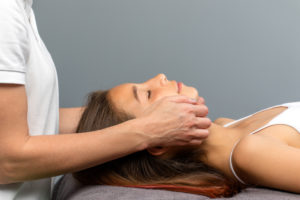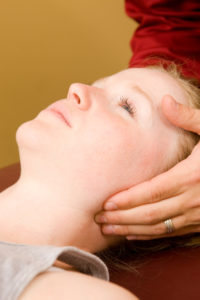What Is Temporomandibular Joint Disorder?
Temporomandibular joint disorder (TMD) is a common condition that limits the natural function of the jaw, such as opening the mouth and chewing, and can cause pain. The temporomandibular joint (TMJ) is a hinge joint that connects your jaw to your skull in front of your ear. The TMJ guides jaw movement and allows you to open and close your mouth and move it from side to side to talk, yawn, or chew. TMD can be caused by:
- Bad posture habits. One of the reasons TMD is so common is because many of us spend a great deal of time sitting at a desk, where we often hold our heads too far forward as we work. But there are many other kinds of bad posture. Sitting in the car for a long commute, working at a checkout station, always carrying your child on the same hip—all can place the head in an awkward position and cause jaw problems. The “forward head position” puts a strain on the muscles, disk, and ligaments of the TMJ. The jaw is forced to “rest” in an opened position, and the chewing muscles become overused.
- Chronic jaw clenching (“bruxism”). Many people clench their jaws at night while they sleep, usually because of stress. Some clench their teeth throughout the day as well, especially when dealing with stressful situations. This puts a strain on the TMJ and its surrounding muscles.
- Problems with teeth alignment (“malocclusion”). If your teeth are positioned in an unusual way, greater stress is placed on the TMJ when performing everyday jaw motions, such as chewing.
- Fracture. In a traumatic accident involving the face or head, a fracture to the lower jaw may result and cause TMD. Even when the fracture is fully healed, TMJ stiffness and pain may remain.
- Surgery. Individuals may experience a loss of TMJ mobility and function following certain kinds of surgery to the face and jaw.
- Trismus (“lockjaw”). This condition—where the jaw muscles spasm and the jaw cannot be fully opened—can be both a cause and a symptom of TMD. Other causes of trismus include trauma to the jaw, tetanus, and radiation therapy to the face and neck.
- Displacement of the disc or soft-tissue cushion located between the ball and socket of the TMJ, which causes popping or clicking of the jaw and, frequently, pain.
- Arthritis in the TMJ.
How Can a Physical Therapist Help?
Your physical therapist can help you restore the natural movement of your jaw and decrease your pain. Based on your condition, your therapist will select treatments that will work best for you. Your treatments may include:
Posture Education. If you sit with your head in an increased forward position, you are placing greater strain on the muscles beneath your chin, causing the lower jaw to pull back and the mouth to be in an open position even when resting, increasing stress on the TMJ. You also might be overworking the jaw muscles to force the jaw closed so your mouth isn’t open all the time. Your physical therapist will teach you to be aware of your posture so that you can improve the resting position of your jaw, head, neck, breastbone, and shoulder blades when you’re sitting and walking.
Improving Jaw Movement. Physical therapists use skilled hands-on techniques (manual therapy) to gently increase movement and relieve pain in tissues and joints. Your physical therapist may use manual therapy to stretch the jaw in order to restore normal joint and muscle flexibility or break up scar tissues (“adhesions”) that sometimes develop when there is constant injury. Your physical therapist will teach you special “low-load” exercises that don’t exert a lot of pressure on your TMJ, but can strengthen the muscles of the jaw and restore a more natural, pain-free motion.
Special Pain Treatments. If your pain is severe, your physical therapist may provide treatments, such as electrical stimulation or ultrasound to reduce it.
Referral to a Dentist. If your TMD is caused by teeth alignment problems, your physical therapist can refer you to a dentist who specializes in TMD, who can correct the alignment with special appliances, such as “bite guards” that create a natural resting position to relax the TMJ, relieve pain, and improve jaw function.

